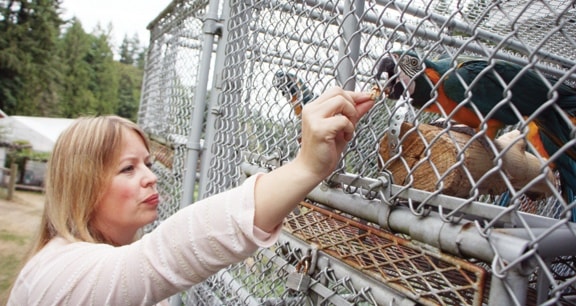According to the World Parrot Trust, for every blue-throated macaw in the wild, there are 3,750 African elephants, 200 rhinos, 12 giant pandas, and six mountain gorillas.
That's about to change, however slightly, with the release of 17 birds raised in Shawnigan Lake.
Those birds are among 27 who are leaving April Sanderson's Shawnigan Lake aviary this week. Five breeding pairs will remain in Toronto, where African
Lion Safari will take over Sanderson's breeding program, while the majority will eventually head to Bolivia to be gradually released into their natural habitat.
It is the result of a lifetime with parrots.
"I've had parrots since I was a child," said Sanderson, who will still have three blue-throated macaws - her pets - when all is said and done. "I got my first one when I was nine, and I've worked with them all my life."
Sanderson started breeding parrots for the pet trade, but soon discovered that wasn't a business she wanted to be part of, particularly since many pet parrots end up in unfortunate circumstances.
"A lot of people don't know how to care for parrots," she noted.
Not wanting to give up working with the birds altogether, Sanderson decided to breed them for the World Parrot Trust's conservation program.
That has involved an extreme amount of permits and contracts, and the birds have all been quarantined at her aviary for the last five years, with no contact with other parrots or even other parrot owners.
It has also required at least three hours of labour a day, seven days a week, limiting family holidays, and cost hundreds of dollars a month to keep them fed and sheltered.
"It has been hard for my family to understand," Sanderson admitted.
Sanderson's five breeding pairs represent nine different bloodlines, probably one of the most diverse breeding groups in North America, which will help prevent inbreeding in the wild.
Parrot release programs are controversial, which Sanderson readily acknowledges.
"There are two teams," she explained.
"One wants to protect the existing population, and the other wants to release more birds."
The wild population of blue-throated macaws is estimated at around 125, within an area roughly the size of Vancouver Island. Breeding pairs usually have just one chick per year. The survival rates of those few chicks are low, and Sanderson believes releases are necessary.
"With numbers so low, I don't believe they can recover without human intervention," she said.
The efforts in Bolivia are modeled after the successful Ara Project, which has helped reintroduce two species of macaw in Costa Rica.
The birds are closely watched, and will begin their time in South America in huge aviaries, where they will be able to build their flight wings, transition to the wild diet, and get accustomed to the climate.
Despite all her hard work, and that of everyone involved in Toronto and Bolivia, Sanderson has accepted that there won't be a 100 per cent survival rate once the birds are released, but still feels it's worth it.
"They're not all going to make it," she said.
"I'm not being naive about it. I know some of them are going to die, but what are the species' chances? Our generation could be the last one to see them."
